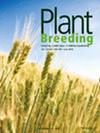德国和美国 "大平原 "基因型杂交小麦(Triticum aestivum L.)在不同目标环境下的互交评价
IF 1.8
4区 农林科学
Q2 AGRONOMY
引用次数: 0
摘要
杂交小麦可以提高粮食产量(GY)和稳定性水平,以应对气候变化,同时,杂交小麦的基因差异池应最大限度地提高异质性。我们将来自美国内布拉斯加州的 22 个育种品系与两个德国栽培品种杂交,产生了 44 个杂交种。杂交种、亲本和 12 个对照连续两年在多个地点对其不同的目标环境中的 GY、株高和开花生物学特性进行了相互测试。目标环境内的性状变异对表现的影响最大。因此,尽管利用天气变量进行了明显的聚类,但仍无法从目标环境中得出巨型环境。植株矮小和局部优化的开花生物学特性是作物表现和适应性的主要驱动因素。通过基因分型测序得出的修正罗杰斯距离揭示了德国和 "大平原 "基因库之间的遗传差异。然而,这种差异并不能解释 GY 异质性的变化。一般来说,杂交种在不同目标环境下的基因比本地适应材料的基因更稳定,而在内布拉斯加 "大平原 "恶劣的气候条件下,基因的异质性更高。本文章由计算机程序翻译,如有差异,请以英文原文为准。
Reciprocal Evaluation of Hybrid Wheat (Triticum aestivum L.) Crosses Between German and US ‘Great Plains’ Genotypes Across Their Contrasting Target Environments
Hybrid wheat could deliver the grain yield (GY) and stability levels to confront climate change while crossing genetically divergent pools should maximize heterosis. We crossed 22 breeding lines from Nebraska (USA) with two German cultivars to produce 44 hybrids. Hybrids, parents and 12 checks were reciprocally tested across their contrasting target environments for GY, plant height and flowering biology during 2 consecutive years at multiple locations. Trait variation within target environments had the greatest impact on performance. Therefore, mega‐environments could not be derived from target environments despite a clear clustering using weather variables. Short plants and locally optimized flowering biology were main drivers for crop performance and adaptation. Modified Rogers' distances derived from genotyping‐by‐sequencing revealed the genetic divergence between German and ‘Great Plains’ pools. However, variation on GY heterosis could not be explained by this divergence. In general, GY of hybrids was more stable across target environments than for locally adapted material, whereas GY heterosis was higher under harsh climate conditions of the Nebraska's ‘Great Plains’.
求助全文
通过发布文献求助,成功后即可免费获取论文全文。
去求助
来源期刊

Plant Breeding
农林科学-农艺学
CiteScore
4.40
自引率
5.00%
发文量
74
审稿时长
3.0 months
期刊介绍:
PLANT BREEDING publishes full-length original manuscripts and review articles on all aspects of plant improvement, breeding methodologies, and genetics to include qualitative and quantitative inheritance and genomics of major crop species. PLANT BREEDING provides readers with cutting-edge information on use of molecular techniques and genomics as they relate to improving gain from selection. Since its subject matter embraces all aspects of crop improvement, its content is sought after by both industry and academia. Fields of interest: Genetics of cultivated plants as well as research in practical plant breeding.
 求助内容:
求助内容: 应助结果提醒方式:
应助结果提醒方式:


